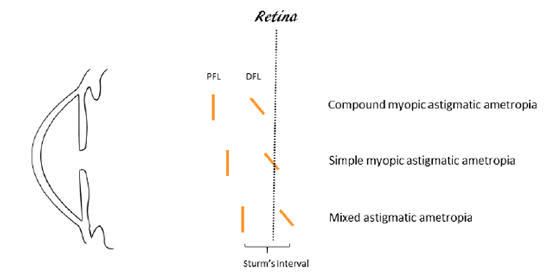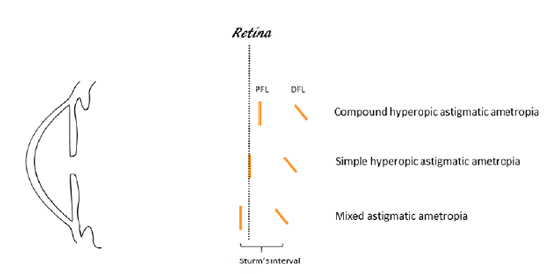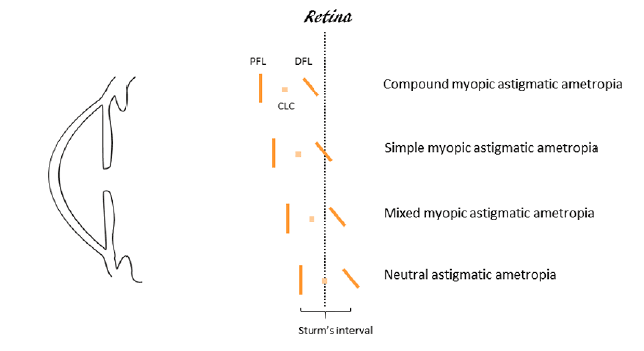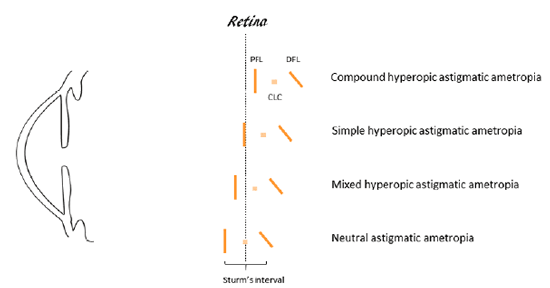Sidney Julio Faria e Sousa
DOI: 10.17545/eoftalmo/2018.0021
ABSTRACT
The traditional classification of astigmatic ametropia is based on the position of the focal lines of the Sturm’s interval relative to the retina. The inconsistency of using the focal lines as a reference becomes evident in the mixed group, which does not specify the spherical refractive condition of the eye. This study aims to propose a novel classification for astigmatic ametropia that fills this void becoming, therefore, more useful than the current one.
Keywords: Astigmatism; Refractometry; Refractive Errors.
RESUMO
A classificação tradicional da ametropia astigmática baseia-se na posição das linhas focais do intervalo de Sturm em relação à retina. A inconsistência do uso das linhas focais como referência torna-se evidente no grupo misto, uma vez que ele não especifica a condição refrativa esférica do olho. O cavalgamento da retina pelo intervalo de Sturm não fornece pistas que identifique se o olho é míope, hipermetrope ou esfericamente emetrope. Este artigo propõe uma nova classificação para a ametropia astigmática que é mais útil que a atual pelo fato de preencher essa lacuna conceitual.
Palavras-chave: Astigmatismo; Refratometria; Erros Refrativos.
RESUMEN
La clasificación tradicional de la ametropía astigmática se basa en la posición de las líneas focales del intervalo de Sturm con relación a la retina. La inconsistencia del uso de las líneas focales como referencia se vuelve evidente en el grupo mixto, dado que no especifica la condición refractiva esférica del ojo. La sobreposición de la retina en el intervalo de Sturm no suministra pistas que identifiquen si el ojo es miope, hipermétrope o esféricamente emétrope. Este artículo propone una nueva clasificación para la ametropía astigmática que es más útil que la actual por el hecho de rellenar esa laguna conceptual.
Palabras-clave: Astigmatismo; Refractometría; Errores de Refracción.
INTRODUCTION
Astigmatism is a term used to identify both an ametropia and an aberration. Astigmatic ametropia (AA), in particular, is a combination of a spherical ametropia (or emmetropia) with an astigmatic aberration. Although this way of understanding AA is seldom mentioned in the literature, it is the implicit assumption when using the spherical equivalent (SEa) to evaluate the spherical component of refractive errors corrected with spherocylindrical lenses. This reason explains why SEa is so well known among those who work with eyeglass lenses, contact lenses, corneal topography, cataract surgery, refractive surgeries, and cross-linking.
Not only is the name astigmatism ambiguous, but also is its classification. Traditionally, AA was classified as myopic, hyperopic, and mixed.1 It is myopic when both focal lines of Sturm’s interval are in front of the retina, or when one of them is in front of, and the other is on, the retina (Fig. 1). The first event configures a compound myopic, and the second, a simple myopic AA. An AA is hyperopic when both focal lines are behind the retina, or when one of them is behind, and the other is on the retina (Fig. 2). The first condition represents a compound hyperopic, and the second a simple hyperopic AA. Mixed AA is when the proximal focal line is in front of, and the distal focal line is behind, the retina (Figs. 1 and 2).


The traditional classification of AA relies, therefore, on the position of the focal lines of Sturm’s interval relative to the retina. The inconsistency of using focal lines as a reference becomes evident in the mixed group, which does not specify the spherical refractive condition of the eye. The straddling of the retina by Sturm’s interval does not indicate whether the eye is myopic, hyperopic or spherically emmetropic. This article proposes a novel classification for astigmatic ametropia that is more useful than the current one by filling this conceptual gap.
NEW CLASSIFICATION OF ASTIGMATISM
By replacing the limits of Sturm’s interval with the circle of least confusion (CLC) as the reference point for the classification of AA, we propose a straightforward classification that is perfectly aligned with SEa . In this novel line of reasoning, AA is classified as myopic, hyperopic, and neutral when the CLC is in front of (SEa < 0), behind (SEa > 0), and on the retina (SEa = 0), respectively.
This classification is agreeable with the concept that AA is a combination of spherical ametropia — quantified by SEa, — with astigmatic aberration — computed by the dioptric extension of Sturm’s interval. 2 Despite its simplicity, it is sufficient for dealing with all the practical aspects of AA. However, for the sake of completeness, it can be expanded to include the classical concepts of compound, simple, and mixed astigmatism. With this addition, myopic and hyperopic AAs become subdivided into compound, simple, and mixed forms like in the traditional classification (Figs. 3 – 4, and Table 1).

 .
.
Therefore, the new classification to its full extent includes the following categories:
(1) Compound myopic astigmatic ametropia.
(2) Simple myopic astigmatic ametropia.
(3) Mixed myopic astigmatic ametropia.
(4) Neutral astigmatic ametropia.
(5) Mixed hyperopic astigmatic ametropia.
(6) Simple hyperopic astigmatic ametropia.
(7) Compound hyperopic astigmatic ametropia.
REFERENCES
1. Duke-Elder S, Abrams D. The optical condition in astigmatism. In: Duke-Elder S, , ed. Ophthalmic Optics and Refraction, System of Ophthalmology, Volume V. London: Henry Kimpton; 1970. p. 283-6.
2. Faria-e-Sousa SJ, Alves MR. Astigmatism: Aberration or ametropia? eOftalmo. 2018;4(1):26-32. DOI: http://dx.doi.org/10.17545/eoftalmo/2018.0004

Funding: No specific financial support was available for this study
CEP Approval: Not applicable
Disclosure of potential conflicts of interest: None of the authors have any potential conflict of interest to disclose
Received on:
June 14, 2018.
Accepted on:
August 22, 2018.